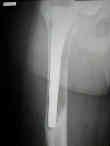
See: Total Hip Replacement Menu:
revision arthroplasty menu
Femoral Revision
exposure of femur
- it is essential that prior to attempted femoral component removal, that there is a clear retrograde path for stem removal;
- this means that any trochanteric overhang is removed, either with a high speed bur or with an trochanteric osteotomy:
- some recommend routine trochanteric osteotomy;
removal of femoral component: (trochanteric osteotomy)
- removal of broken femoral stems:
- removal of cementless stems:
- removal of cemented femoral stems:
- femoral windowing:
- indications:
- presence of a large cortical pedestal which lies at the stem tip;
- large cement column;
- varus stem position;
- technique:
- motorized burr is used to make a longitudinal window over the area of difficulty;
- indications:
- references:
reaming
- often long curved femoral stems are required, in which case flexible reamers are needed;
- careful to avoid eccentric reaming;
reconstruction of femoral bone defects
- references:
- Revision total hip arthroplasty with osseous allograft reconstruction. A clinical and roentgenographic analysis.
- Freeze-dried proximal femur allografts in revision total hip arthroplasty. A preliminary report.
- Iontophoresed segmental allografts in revision arthroplasty for infection.
- Preparation of the proximal femur in cementless total hip revision.
femoral component insertion
complications
- femur fracture
- references:
- Revision total hip arthroplasty
- Long-term results of revision total hip replacement. A follow-up report.
- Multiple revisions for failed total hip arthroplasty not associated with infection.
- Preparation of the proximal femur in cementless total hip revision.
- The Fate of Well Fixed Cemented Femoral Components Left in Place at the Time of Revision of the Acetabular Component.
- Results of revision for mechanical failure after cemented total hip replacement, 1979 to 1982. A two to five-year follow-up.
- Revision surgery for failed, nonseptic total hip arthroplasty: the femoral side.

